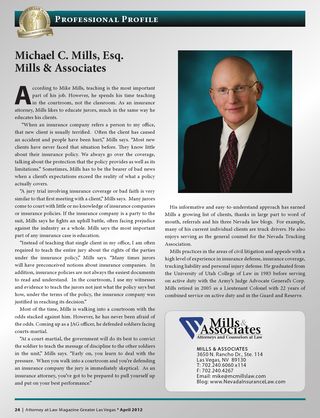 In State Farm Mut. Auto. Ins. Co. v. Hansen, 131 Nev. 743, 357 P.3d 338 (2015) the Nevada Supreme Court adopted the independent counsel model outlined by the California Court of Appeals in San Diego Federal Credit Union v. Cumis Ins. Society, Inc., 208 Cal. Rptr. 494, 506 (Ct. App. 1984), superseded by statute as stated in United Enters., Inc. v. Superior Court, 108 Cal. Rptr. 3d 25 (App 2010). In its opinion issued on September 24, 2015, the Nevada Supreme Court said that an insurance company has a duty to pay for independent counsel for its insured when its interests and those of its insured are in actual conflict. The foundation for this obligation rests in the insurance policy’s duty to defend and the attorney’s professional duty to provide representation without conflict. Nev. R. Prof. Conduct 1.7(a).
In State Farm Mut. Auto. Ins. Co. v. Hansen, 131 Nev. 743, 357 P.3d 338 (2015) the Nevada Supreme Court adopted the independent counsel model outlined by the California Court of Appeals in San Diego Federal Credit Union v. Cumis Ins. Society, Inc., 208 Cal. Rptr. 494, 506 (Ct. App. 1984), superseded by statute as stated in United Enters., Inc. v. Superior Court, 108 Cal. Rptr. 3d 25 (App 2010). In its opinion issued on September 24, 2015, the Nevada Supreme Court said that an insurance company has a duty to pay for independent counsel for its insured when its interests and those of its insured are in actual conflict. The foundation for this obligation rests in the insurance policy’s duty to defend and the attorney’s professional duty to provide representation without conflict. Nev. R. Prof. Conduct 1.7(a).
The Court’s analysis is simple. When most attorneys are assigned by an insurance company to defend a Nevada insured, there is no conflict of interest. That attorney will represent both the insured and the insurance company. This dual representation is authorized by the Nevada Rules of Professional Conduct as described in Nev. Yellow Cab Corp. v. Eighth Judicial Dist. Court, 123 Nev. 44, 52, 152 P.3d 737, 742 (2007). As the Nevada Law Blogs have chronicled in its posts leading up to this decision, the parties asked the Nevada Supreme Court to define the responsibilities of the insurance companies and of the attorneys when such conflicts arise.
State Farm and its allies argued that when an actual conflict arises, the attorney could represent just the insured thereby terminating the “dual representation” status of the assigned attorney. The Nevada Supreme Court rejected that argument saying that this “primary client” model would not work under Nevada’s Rules of Professional Conduct. The Court explained:
RPC 1.9(a) prohibits “[a] lawyer who has formerly represented a client in a matter” from representing a client “in the same or a substantially related matter in which that person’s interests are materially adverse to the interests of the former client unless the former client gives informed consent, confirmed in writing.” Therefore, the primary client model appears to be unworkable in a dual-representation jurisdiction.
131 Nev. Adv. Op. 74 at 7.
However, the court would not go so far as to say that every reservation of right letter triggers an insurance company’s duty to pay for an independent counsel. The court explained that “there is no conflict if the reservation of rights is based on coverage issues that are only extrinsic or ancillary to the issues actually litigated in the underlying action.” Id. at 12.
The court explained that:
Courts must inquire, on a case-by-case basis, whether there is an actual conflict of interest. This approach follows Nevada law: We have held that dual-representation is appropriate as long as there is “no actual conflict.” See Nev. Yellow Cab, 123 Nev. at 51, 152 P.3d at 741. And we have approvingly cited opinions holding that “joint representation is permissible as long as any conflict remains speculative.” Id. Moreover, because the Cumis rule derives from rules of professional conduct, see MBL, 160 Cal. Rptr. 3d at 920, it follows that the appropriate standard is whether there is an actual conflict under RPC 1.7. Therefore, an insurer is obligated to provide independent counsel of the insured’s choosing only when an actual conflict of interest exists. A reservation of rights does not create a per se conflict of interest.
Id. at 12.
In deciding whether an actual conflict exists, the court said that it would follow the model laid out in the California Statute and case law interpreting it. The court said:
Other jurisdictions look to the facts of the case to determine whether there is an actual conflict. Courts in these jurisdictions stress that the point of the Cumis rule is to enforce conflict-of-interest rules, so the focus should be on whether there is actually a conflict. See, e.g., Fed. Ins. Co. v. MBL, Inc., 160 Cal. Rptr. 3d 910, 920 (Ct. App. 2013). Courts must therefore consider whether a conflict of interest exists and not simply look for a reservation of rights. See id.
For example, in California, the codified Cumis rule requires an actual conflict of interest; it does not apply to every case in which there is a reservation of rights.”[W]hen an insurer reserves its rights on a given issue and the outcome of that coverage issue can be controlled by counsel first retained by the insurer for the defense of the claim, a conflict of interest may exist.” Cal. Civ. Code § 2860(b) (West 2014) (emphasis added). There are two elements: (1) a reservation of rights and (2) that the outcome of the coverage determination can be controlled by counsel in the underlying defense of the claim. See id.; Travelers Prop. v. Centex Homes, No. C 10-02757 CRB, 2011 WL 1225982, at *8 (N.D. Cal. Apr. 1, 2011) (applying Cal. Civ. Code § 2860(b) to determine whether conflict existed). But even after laying out those two elements, the statute uses the word “may,” implying that it is still an issue of fact whether a conflict of interest actually exists.
What, then, is the standard that a trial court must apply when looking at whether the facts of the case create a conflict of interest? In California, courts apply the rules of ethics: “[T]he Cumis rule is not based on insurance law but on the ethical duty of an attorney to avoid representing conflicting interests. For independent counsel to be required, the conflict of interest must be significant, not merely theoretical, actual, not merely potential.” MBL, 160 Cal. Rptr. 3d at 920 (internal quotations omitted). Therefore, even when (1) there is a reservation of rights and (2) insurer-provided counsel has control over an issue in the case that will also decide the coverage issue, courts must still determine whether there is an actual conflict of interest. This means that there is no conflict if the reservation of rights is based on coverage issues that are only extrinsic or ancillary to the issues actually litigated in the underlying action. See id.
Id. at 10-12.
The Nevada Law Blogs have compared this conflict between insurance companies and their insured as a film version of an old west showdown at noon. As the weeks and months play out, expect any number of sequels involving others being cast as the sheriff with the “silver star” and the outlaw. Nevada Law Blogs predict that Nevada insurance companies will see an increase in requests for independent counsel. There will be many questions as to whether the duty to provide independent counsel has been triggered. Expect ensuing litigation involving the hourly rates that these attorneys can charge, the reporting duties of independent counsel to the insurance companies and whether the attorneys must comply with company guidelines and standards. Most important however, insurance companies will face allegations of a breach of the duty to defend based upon a failure to assign or a failure to pay for independent counsel requested by the insured. Stay tuned to the Nevada Law Blogs for updates on these issues.
If you have questions about whether “independent counsel” is required, please contact Mike Mills at 702-240-6060×114 to discuss your situation.
 Follow
Follow Email
Email


